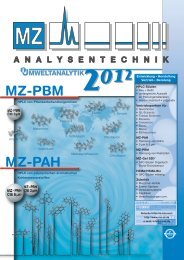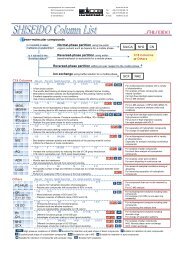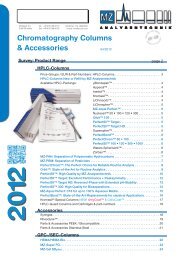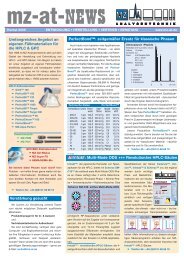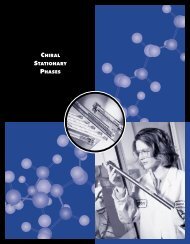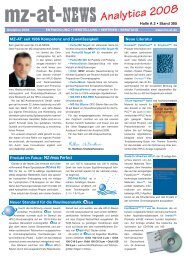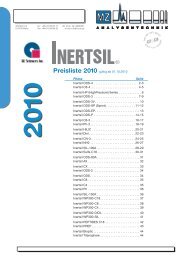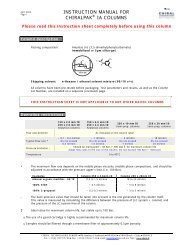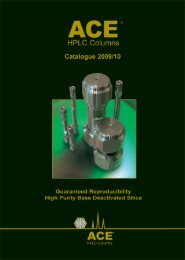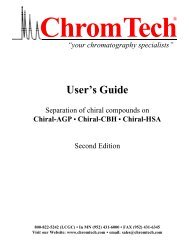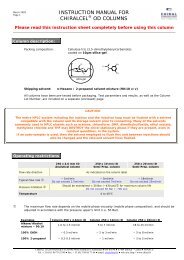You also want an ePaper? Increase the reach of your titles
YUMPU automatically turns print PDFs into web optimized ePapers that Google loves.
LC/MS<br />
<strong>ACE</strong> LC/MS and Rapid Analysis Columns<br />
Increased Column Robustness<br />
The requirement for long lifetime columns is essential for<br />
high throughput analyses, where mid-run column failure<br />
must be avoided. The high flow, fast gradient conditions<br />
typically employed have been shown to cause premature<br />
column bed failure due to the rapid pressure and solvent<br />
miscibility changes within the column itself. <strong>ACE</strong> LC/MS<br />
and rapid analyses columns are manufactured by a unique<br />
process which results in increased column bed stability,<br />
thus increasing column lifetime. As shown in Figure 30a ,<br />
<strong>ACE</strong> columns significantly outlast a leading competitor<br />
column when tested under generic fast gradient<br />
conditions.<br />
LC/MS Buffer Compatibility<br />
A number of independent studies (see pages 2, 3, 12, 13,<br />
19, 23 and 29) have shown <strong>ACE</strong> columns to be the most<br />
inert on the market. This makes <strong>ACE</strong> the column of choice<br />
for LC/MS due to the extremely low requirement for buffer<br />
salts or modifiers to achieve good peak shape.<br />
<strong>ACE</strong> columns have been demonstrated to be extremely<br />
robust at high and low pH (see pages 8 and 9). This broad<br />
pH operating range enables thorough optimization of pH<br />
and simplifies method development to a single column<br />
rather than selecting 3 different columns with low,<br />
intermediate and high pH stability.<br />
For maximum LC/MS compatibility under acidic conditions<br />
organic acids such as formic, acetic and TFA are<br />
recommended. Under basic conditions ammonium<br />
bicarbonate, ammonium acetate and ammonium hydroxide<br />
buffers are recommended.<br />
Figure 30b demonstrates the resolution obtained with 2<br />
basic compounds at different mobile phase pHs on an <strong>ACE</strong><br />
ultra-inert HPLC column.<br />
30<br />
Figure 30a. <strong>ACE</strong> Column Robustness<br />
% Efficiency<br />
100<br />
80<br />
60<br />
40<br />
Leading Competitor 3µm C8<br />
No. of Gradient Cycles<br />
<strong>ACE</strong> 3 C8<br />
0 1000 2000 3000 4000 5000<br />
Column Dimensions: 50 x 3.0mm, 3µm C8, Flow Rate: 1.25ml/min<br />
Mobile Phase: A: 5:95 MeCN/10mM NH 4OAc, B: 95:5 MeCN/10mM NH 4OAc<br />
Gradient: T(mins) 0 2.25 2.50 3.00<br />
%A 0 100 0 0<br />
%B 100 0 0 100<br />
Figure 30b. pH Investigation with LC/MS Buffers<br />
pH 2<br />
0.1% TFA<br />
pH 3.0<br />
10mM NH 4COOH<br />
pH 7.0<br />
10mM NH 4HCO 3<br />
pH 10.0<br />
10mM NH 4HCO 3<br />
pH 10.5<br />
10mM NH 4 OH<br />
1 2<br />
1 2<br />
1 2<br />
1<br />
1<br />
Increased<br />
retention<br />
of basic<br />
molecules<br />
Column: <strong>ACE</strong> 3 C18, 50 x 2.1 mm i.d., Flow Rate: 0.20ml/min Mobile Phase: 80:20 MeOH/buffer,<br />
Temperature: 22ºC Sample: 1) Nortriptyline 2) Amitriptyline, Wavelength: 215 nm<br />
<strong>ACE</strong> HPLC columns have a broad pH operating range, allowing<br />
simplified method development on a single column.<br />
2<br />
2



